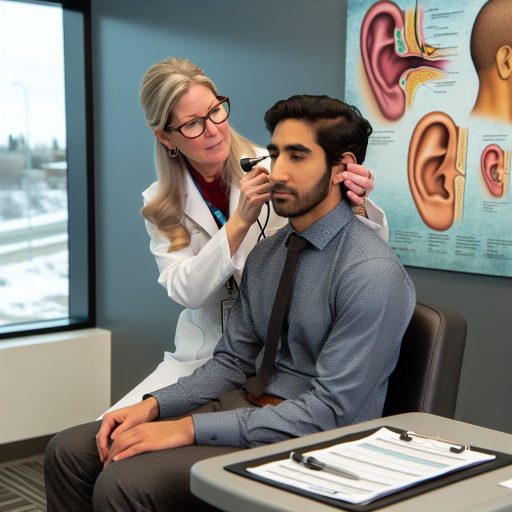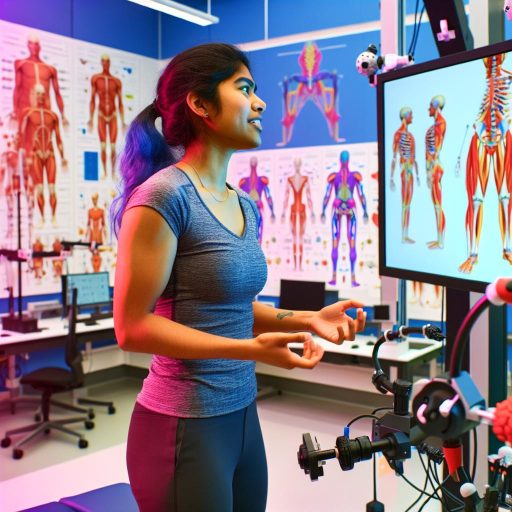Introduction to Kinesiology and Its Importance in Health
Kinesiology explores human movement and its effects on physical well-being.
This field combines anatomy, physiology, biomechanics, and motor learning.
Kinesiologists play a crucial role in enhancing physical health.
They assess movement patterns to improve physical performance and prevent injuries.
Moreover, they develop personalized exercise programs tailored to individual needs.
Kinesiology promotes rehabilitation after injuries or surgeries.
Thus, it aids individuals in returning to their daily activities safely.
Furthermore, kinesiologists educate clients about the benefits of physical activity.
They help individuals adopt healthier lifestyles to improve overall well-being.
Additionally, kinesiologists work in various settings, including clinics and fitness centers.
In these environments, they collaborate with other healthcare professionals.
This teamwork ensures comprehensive care for patients and clients.
Ultimately, kinesiology is vital for enhancing quality of life through movement.
Overview of Kinesiologists’ Roles in Different Settings
Role in Rehabilitation Clinics
Kinesiologists play a vital role in rehabilitation clinics.
They help patients recover from injuries effectively.
By crafting personalized rehabilitation programs, they enhance recovery speed.
Additionally, they educate patients on injury prevention strategies.
This promotes safer engagement in physical activities.
Contribution to Sports Teams
In sports teams, kinesiologists maximize athletic performance.
They conduct assessments to identify strengths and weaknesses.
Furthermore, they implement training programs tailored to each athlete.
Their expertise helps prevent injuries during training and competitions.
Moreover, they utilize techniques to enhance flexibility and strength.
Involvement in Corporate Wellness Programs
Kinesiologists contribute significantly to corporate wellness programs.
They design programs to improve employee health and productivity.
Unlock Your Career Potential
Visualize a clear path to success with our tailored Career Consulting service. Personalized insights in just 1-3 days.
Get StartedThese programs often include ergonomic assessments to prevent injuries.
Additionally, kinesiologists offer workshops on physical activity.
Such initiatives foster physically active workplaces.
Engagement with Community Health Initiatives
Community health initiatives also benefit from kinesiologists’ expertise.
They promote physical activity and healthy lifestyles in various populations.
These professionals often lead community exercise programs.
Their efforts improve overall community wellness and health metrics.
They work collaboratively with local organizations to achieve these goals.
Collaboration with Healthcare Professionals
Kinesiologists often collaborate with other healthcare providers.
This multidisciplinary approach results in comprehensive care.
Their input enhances treatment plans for patients with chronic conditions.
They offer valuable insights on movement and function.
Ultimately, this collaboration improves patients’ quality of life.
Assessment Techniques Used by Kinesiologists to Evaluate Physical Health
Functional Movement Screening
Kinesiologists utilize functional movement screening to analyze movement patterns.
This assessment helps identify functional limitations and imbalances.
Additionally, it provides valuable information for tailored exercise prescriptions.
Postural Assessment
Postural assessments are crucial for evaluating spinal alignment and overall posture.
Kinesiologists assess static and dynamic postures to detect issues.
By doing this, they can recommend corrective exercises to improve posture.
Muscle Strength Testing
Assessing muscle strength is a critical part of a kinesiologist’s evaluation process.
The use of handheld dynamometers offers precise strength measurements.
This data helps in developing effective rehabilitation programs.
Cardiovascular Fitness Assessment
Kinesiologists evaluate cardiovascular fitness using various methods.
Common techniques include the VO2 max test and the Rockport Walk Test.
These assessments gauge heart and lung efficiency during physical activity.
Flexibility Testing
Flexibility assessments are performed to measure the range of motion.
Standard methods include the sit-and-reach test and goniometry.
Improving flexibility can enhance overall physical performance and reduce injury risk.
Gait Analysis
Gait analysis provides insights into how a person walks and moves.
Kinesiologists observe stride length, speed, and symmetry.
Identifying abnormalities aids in developing targeted interventions.
Client Questionnaires
Client questionnaires gather subjective information on health history.
These forms help kinesiologists understand individual goals and concerns.
Such insights are vital for creating customized health plans.
Explore Further: Skills Needed To Become A Speech-Language Pathologist
Designing Personalized Exercise Programs to Enhance Well-Being
Understanding Individual Needs
Kinesiologists begin by assessing each individual’s unique goals.
This process includes evaluating fitness levels and health conditions.
Understanding personal preferences also plays a critical role.
Such information forms the foundation for a tailored exercise program.
Setting Realistic Goals
Collaboration is key when establishing achievable fitness goals.
Kinesiologists work with clients to set both short-term and long-term objectives.
These targets must align with the individual’s capabilities and lifestyle.
Moreover, recognizing potential barriers can enhance success rates.
Creating Customized Exercise Plans
Based on the initial assessments and goals, kinesiologists design tailored programs.
This may include a mix of cardiovascular, strength, and flexibility exercises.
Additionally, personalized plans adapt to the individual’s progress over time.
Maintaining variety ensures clients remain motivated and engaged.
Monitoring Progress and Adjusting Programs
Regular assessments allow kinesiologists to track progress effectively.
As clients improve, adjustments to the exercise plans ensure continued growth.
Using feedback helps maintain a focus on individual needs and goals.
This ongoing support contributes significantly to overall well-being.
Incorporating Holistic Approaches
Kinesiologists often incorporate wellness strategies into exercise programs.
These strategies may include nutrition advice and stress management techniques.
A holistic approach enhances physical fitness while addressing mental health.
Ultimately, this improves overall quality of life for clients.
See Related Content: Challenges Speech-Language Pathologists Often Face
Collaboration Between Kinesiologists and Other Health Professionals
Importance of Interdisciplinary Teams
Kinesiologists play a vital role in health care teams.
They bring a unique perspective on movement and rehabilitation.
Additionally, they enhance patient outcomes through collaboration.
Working with Physiotherapists
Kinesiologists often work alongside physiotherapists.
Together, they design effective rehabilitation programs.
This teamwork helps patients recover from injuries more efficiently.
Moreover, they ensure a holistic approach to movement therapy.
Collaboration with Nutritionists
Nutritional guidance is crucial for overall health.
Kinesiologists collaborate with nutritionists to create comprehensive plans.
These plans address both movement and dietary needs.
As a result, clients receive well-rounded support for wellness.
Engagement with Occupational Therapists
Occupational therapists focus on improving daily functioning.
Kinesiologists contribute their expertise in physical movement.
This partnership enhances a client’s ability to perform tasks.
Ultimately, it promotes greater independence and quality of life.
Partnership with Chiropractors
Kinesiologists and chiropractors often work together closely.
They combine their skills to address musculoskeletal issues.
This collaboration maximizes patient recovery and pain management.
Furthermore, it helps prevent future injuries through education.
Integrating Mental Health Professionals
Mental health is integral to physical well-being.
Kinesiologists collaborate with psychologists or counselors.
They help clients build resilience and cope with stress.
This integrated approach promotes comprehensive health.
Explore Further: Challenges And Rewards Of Being An Audiologist
The Impact of Kinesiological Interventions on Rehabilitation
Understanding Kinesiological Interventions
Kinesiologists utilize movement science to enhance physical rehabilitation.
They assess individual movement patterns to identify areas for improvement.
Through targeted interventions, kinesiologists aim to restore function and mobility.
Effective rehabilitation often involves personalized exercise programs.
Types of Rehabilitation Techniques
Kinesiological techniques vary based on the patient’s needs.
Common methods include manual therapy and therapeutic exercises.
Technology, such as biofeedback, may aid in improving performance.
Educational resources inform patients about their conditions.
Benefits of Kinesiological Approaches
Kinesiological interventions promote faster recovery from injuries.
They enhance strength and flexibility in patients of all ages.
Moreover, these approaches decrease the risk of re-injury.
Patients often report improved overall quality of life.
Collaboration with Healthcare Professionals
Kinesiologists often work alongside physical therapists and doctors.
This collaboration ensures comprehensive care for each patient.
They share insights to develop cohesive rehabilitation plans.
This team approach maximizes the effectiveness of interventions.
Delve into the Subject: Understanding the Scope of Kinesiology in Health Care

Kinesiologists’ Role in Promoting Injury Prevention and Management
Understanding Kinesiology
Kinesiologists study human movement and physical activity.
They apply scientific principles to enhance physical well-being.
Consequently, they focus on improving performance and preventing injuries.
Injury Prevention Strategies
Kinesiologists implement various strategies to prevent injuries.
They assess individual physical abilities and limitations.
This assessment helps identify potential injury risks.
Moreover, they design tailored exercise programs to mitigate these risks.
Having established a baseline is essential for injury prevention.
Education on Safe Practices
Kinesiologists educate clients about safe movements and techniques.
They teach proper body mechanics for daily activities.
Furthermore, they emphasize the importance of warm-up and cool-down routines.
Activity-Specific Training
Kinesiologists create sport-specific conditioning programs.
This training enhances performance while reducing injury risks.
Additionally, they guide athletes on optimal recovery practices.
Management of Existing Injuries
Kinesiologists play a crucial role in managing existing injuries.
They develop rehabilitation programs aimed at recovery.
Assessment of injuries allows for a targeted approach to rehabilitation.
Furthermore, they use therapeutic exercises to restore strength and mobility.
Collaboration with Other Professionals
Kinesiologists often collaborate with physiotherapists and doctors.
This teamwork ensures a comprehensive approach to injury management.
They share insights and resources for optimal patient care.
Monitoring Progress
Kinesiologists monitor clients’ progress throughout rehabilitation.
They adjust exercise programs based on individual recovery rates.
Regular assessments keep clients informed and motivated.
Promoting Lifelong Physical Activity
Kinesiologists advocate for lifelong engagement in physical activity.
They emphasize the role of activity in maintaining overall health.
Encouraging habits that prevent future injuries is paramount.
Ultimately, they empower individuals to take charge of their health.
Exploring Evidence-Based Practices in Kinesiology
Foundational Concepts in Kinesiology
Kinesiology encompasses the study of human movement.
It integrates principles from anatomy, physiology, and biomechanics.
This field aims to enhance physical performance and well-being.
Kinesiologists apply their knowledge to design effective interventions.
Thus, they focus on promoting health and preventing injury.
Evidence-Based Practice in Kinesiology
Evidence-based practice is essential in kinesiology.
This approach uses the best available research for decision-making.
It ensures that interventions are effective and safe.
Additionally, it keeps practitioners updated with ongoing research.
Therefore, kinesiologists rely on current guidelines and data.
Assessment Techniques
Assessment is crucial for personalized intervention plans.
Kinesiologists utilize various assessment techniques to evaluate clients.
These techniques may include functional movement screenings.
They also assess strength, flexibility, and range of motion.
Using these assessments, they can identify specific needs.
Functional Movement Screening
Functional movement screenings determine movement quality.
They identify limitations or asymmetries in movement patterns.
These screenings provide valuable insights for tailored interventions.
Strength and Flexibility Assessments
Kinesiologists measure strength and flexibility using standardized tests.
These assessments evaluate overall fitness levels.
Furthermore, they help track progress over time.
Designing Personalized Programs
Kinesiologists develop personalized programs based on assessment results.
Each program considers individual goals and needs.
They incorporate aerobic exercises, strength training, and flexibility routines.
Moreover, incorporating client feedback aids in refining the programs.
Such personalization enhances client adherence and success.
Client-Centered Approach
A client-centered approach emphasizes individual preferences.
Kinesiologists engage clients in the program design process.
This collaboration fosters motivation and commitment.
Monitoring Progress
Monitoring progress is vital for effective kinesiology interventions.
Kinesiologists use periodic assessments to evaluate outcomes.
These evaluations inform necessary adjustments to programs.
Benefits of Kinesiologists’ Interventions
Kinesiologists play a significant role in enhancing well-being.
Their interventions lead to improved physical fitness levels.
Furthermore, they aid in pain management and injury rehabilitation.
Clients often experience increased vitality and energy levels.
Consequently, kinesiologists contribute to a higher quality of life.
Case Studies: Successful Outcomes from Kinesiological Interventions
Improvement in Sports Performance
A local soccer player sought help to enhance her performance.
After six weeks of tailored kinesiological interventions, she improved her agility.
Furthermore, she reported a decrease in frequent injuries.
This case emphasizes the importance of kinesiology in sports.
Post-Surgery Rehabilitation
After knee surgery, a patient named Tom faced significant mobility issues.
The kinesiologist developed a personalized rehabilitation plan for him.
Over months, Tom regained strength and stability in his knee.
Eventually, he returned to his active lifestyle with confidence.
Chronic Pain Management
A woman named Sarah struggled with chronic back pain for years.
She turned to kinesiology for holistic pain management solutions.
Through targeted exercises and posture correction, her pain decreased significantly.
Ultimately, she discovered new strategies for managing her condition.
Enhancement of Daily Activities
John, a retired veteran, was struggling with daily tasks due to physical limitations.
His kinesiologist introduced functional exercises tailored to his needs.
Gradually, he regained his independence in activities like gardening and walking.
This showcases kinesiology’s role in improving quality of life.
Stress Reduction and Mental Health
A college student, Mia, faced high stress levels affecting her well-being.
Kinesiological techniques focused on relaxation and breathing exercises.
As a result, Mia reported feeling more centered and less anxious.
This illustrates the comprehensive approach of kinesiology in enhancing mental health.
Future Trends and Opportunities in Kinesiology for Enhancing Public Wellness
Embracing Technology
Kinesiologists are increasingly leveraging technology to improve client outcomes.
This data allows for personalized training programs and health monitoring.
Moreover, virtual platforms facilitate remote consultations and services.
Expanding Roles in Healthcare
The role of kinesiologists in healthcare continues to expand significantly.
They collaborate with other healthcare professionals to manage chronic conditions.
Additionally, they focus on rehabilitation and injury prevention strategies.
Targeted interventions enhance patient mobility and quality of life.
Focus on Community Wellness Programs
Kinesiology promotes community wellness initiatives that foster physical activity.
These programs often target various demographics, including children and seniors.
Schools and organizations increasingly recognize the importance of these initiatives.
Such efforts lead to improved health outcomes and reduced healthcare costs.
Research and Innovation in Kinesiology
Ongoing research in kinesiology drives innovation in techniques and treatments.
Academic institutions and practitioners work together on impactful studies.
This research contributes to evidence-based practices and improved protocols.
Interdisciplinary Collaboration
Kinesiologists increasingly collaborate with professionals from other fields.
Partnerships with psychologists enhance mental health approaches in treatment.
Collaboration with dietitians helps develop comprehensive wellness plans.
Such interdisciplinary efforts yield holistic benefits for clients.
Education and Awareness Initiatives
Educating the public about physical wellness is crucial for kinesiologists.
Workshops and seminars raise awareness of physical activity benefits.
Information campaigns promote healthy lifestyle choices in communities.
This focus empowers individuals to take charge of their physical well-being.
Additional Resources
Enhancing adapted physical activity training for community …
Kinesiology vs. Physical Therapy: Key Differences & Similarities | CSP




